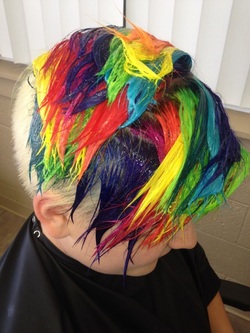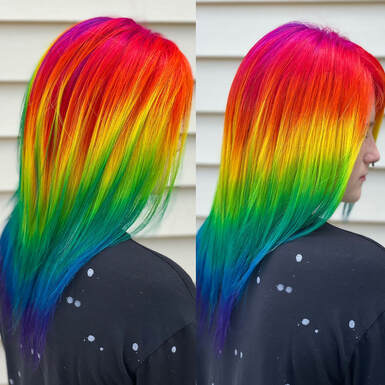 I get questions and commentary on this ALL THE TIME. In fact, almost any time I post a photo with multiple colors in it, the two main sentiments are, “How do you keep that from bleeding?” and, more annoyingly, “That’s gonna look great till she washes it.” There are actually a lot of simple solutions for this. First off, though, it should be noted that I also use color placement to my advantage, so bleeding is often either a non-issue, or is sometimes even desired to create a greater range of colors. However, that’s a subject for another article, so I won’t go into that here. So probably the most important factor with regards to bleeding is water rinsing temperature. Cold water closes the cuticle and traps nearly all the color molecules, preventing their escape. Hot water, conversely, opens the cuticle and lets a huge proportion of the color you just applied go all over the other colors and right down the drain. So, hot water is your enemy here. You will also want to make sure your clients continue to use cold water at home for maximum color separation and longevity, so it’s important to emphasize this as part of their care routine. And no need for cold showers, either; clip the hair up when showering/bathing, and wash it separately leaning over the tub so that only the scalp has to endure the frigidity. I also avoid shampooing after rinsing the color out. I prefer to give the majority of my color clients at least a 24 hour time frame before they can shampoo their hair; it seems to help the color set up better. Otherwise, the lathering and detergents just end up dislodging a lot of the color molecules, and they can end up stuck in other parts of the hair where you don’t want them. So, skip the shampoo on this service. If you’ve got color you’re really nervous about, find a good dry shampoo to retail to your clients for them to keep on hand. Otherwise, give them a sulfate free shampoo to minimize lathering and bleeding, and to maximize longevity and brightness. However, conditioner is okay, and recommended after a color service. Speaking of conditioner, it is also great to use as a color blocker. For instance, if there is hair that I want to stay relatively blonde near some brighter colors, then I will coat the blonde with conditioner during the coloring process, and then it can act as a protective barrier against the color when I rinse. There may still be some slight bleeding onto the blonde once the client starts shampooing at home, but it won’t be near the magnitude of what it would be with the actual dye still on the hair. This was what I used on Haley's blonde hair in the photo above. Occasionally, I may also rinse separately. This tends to consist of selectively removing foils, darkest colors first, and rinsing those before I move on to lighter pieces. I don’t do this often, however, simply due to my color placement strategies; it tends to be unnecessary. It’s also not always practical for your clients to do at home, either, unless there are only 2-3 very large sections and color mixing would be catastrophic. And honestly, I don’t consider bleeding catastrophic, because again, color placement eliminates this issue. But I also tend to hold the philosophy that the evolution and natural changes in the appearance of things is actually kind of cool. I let my clients know that sometimes, their hair will morph or change with each shampoo – and that’s good! It stays interesting, and it’s like getting a new or different color a couple times a week. Keep in mind, however, that agreement with this mindset is probably more likely among a rainbow clientele that changes their color often anyway; standard color clients may not be as impressed or pleased with it. My final strategy if I am feeling desperate or really worried is to let the color dry out on the hair. Yes, dry out. I will put them under the dryer and let all the moisture get sucked out until the color is no longer wet. When rinsing in this situation, you’ll notice that the water is almost completely clear. I discovered this on accident, but to be honest, rarely feel a need to use it. I am also not 100% clear on what effects that may have on the color itself with regards to longevity and other factors, so I would only use this strategy as a last resort. If you are a color educator for a particular brand, however, and you know whether this makes a difference on your color line(s), feel free to help us out in the comments. So that’s how I minimize bleeding. If you have any questions or comments, drop them in the comments below!  Practice some of these strategies yourself on <<<<<<this rainbow wig
77 Comments
|
Sometimes, I write.
Various brain regurgitations will go here. Categories
|
 RSS Feed
RSS Feed